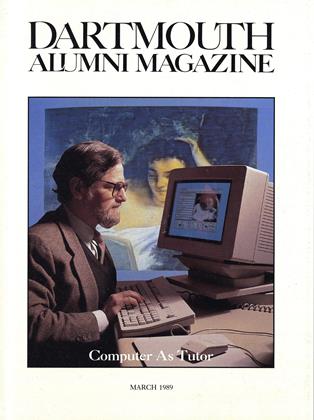HyperCard, a software package released by the Apple Corporation in 1987, stores information on simulated index cards and "stacks" them electronically to form the foundation for each application. The user takes command over the look, feel, and content of the "cards" and their presentation. HyperCard applications have already made possible a variety of complex tasks that otherwise would likely have been unaffordable.
• In Philadelphia, a brain-damaged young woman who can move only a single finger uses a HyperCarddrawn screen keyboard to communicate with the outside world. Physicians and computer experts designed the software in a matter of days to match her special needs.
• The fire chief of a rural, mountainous California community bordering the wine country has devised a HyperCard "stack" to facilitate operations. The computer maps buildings and roadways and documents hazards, multiple alarms and fireprevention efforts.
• Homeowners and businesses are cataloguing insured possessions, business contacts, library resources, genealogies, and the like. Individuals reluctant to commit to hefty database manuals and stringent protocols have found HyperCard easy to customize. • Parents are creating games for their children. Game-show-style programs can do everything Vanna White can do except twirl in fancy dresses. A Los Angeles-based research division of Apple, devoted entirely to educational, interactive software, proclaims HyperCard its finest tool. • "Filled" or customized HyperCard stacks have now flooded the public domain and commercial distribution networks. On the product's first birthday, Apple President John Sculley announced that an estimated 200,000 stacks had been created.
While this is an impressive statistic, not all of the stacks work well. In order to go freely from one picture or block of information to another, someone must have thought of the connection previously and built it into the program. Users are limited to "following tracks laid out by someone else," much as a motorist must stick to a city's streets, observes David Bantz, Dartmouth's director of humanities computing. Someday, he says, the ideal academic computer may "give users the unlimited ability to ask, 'What other buildings have cornices similar to this, how did it vary in other time periods and countries, what were people writing at the time this was done?' "
Today, however, available computers and information resources fall far short of what Bantz envisions. Some of the roadblocks, such as the processing of information into computer-readable form and the settlement of copyright issues, are surmountable today. Other tasks, such as the development of artificial intelligence that can discern subtle contextual meanings that (for now) only humans can grasp, are farther down the road.
In the meantime, Bantz says he looks forward to the day when computers will be able to answer much more interesting questions than how many times the word 'zounds' appears in Shakespeare.
 View Full Issue
View Full Issue
More From This Issue
-
 Feature
FeatureFrom Dartmouth Comes the World's First Love Story
March 1989 By David Birney '61 -
 Cover Story
Cover StoryTeacher in the Dorm Room
March 1989 By Paul Susca '80 -
 Feature
FeatureOn a Freshman Trip, the Destination Is Community
March 1989 By Jay Heinrichs -
 Feature
FeatureWhy I Traded Basketball for Biology
March 1989 By Liz Walter '89 -
 Article
ArticleTHE NATURE OF REALITY
March 1989 By Bruce Pipes, Karen Endicott -
 Article
ArticleOROZCO'S LEGACY
March 1989
Article
-
 Article
ArticleACTIVITIES OF PRESIDENT HOPKINS
March 1917 -
 Article
ArticlePROF. F. J. NEEF APPOINTED HEAD OF PERSONNEL BUREAU
AUGUST, 1927 -
 Article
ArticleGreat Issues Speakers
November 1951 -
 Article
ArticleNew boat house under construction
SEPTEMBER 1985 -
 Article
ArticleA Winner by Six Degrees
SEPTEMBER 1991 -
 Article
Article"American Literature"
APRIL 1994

